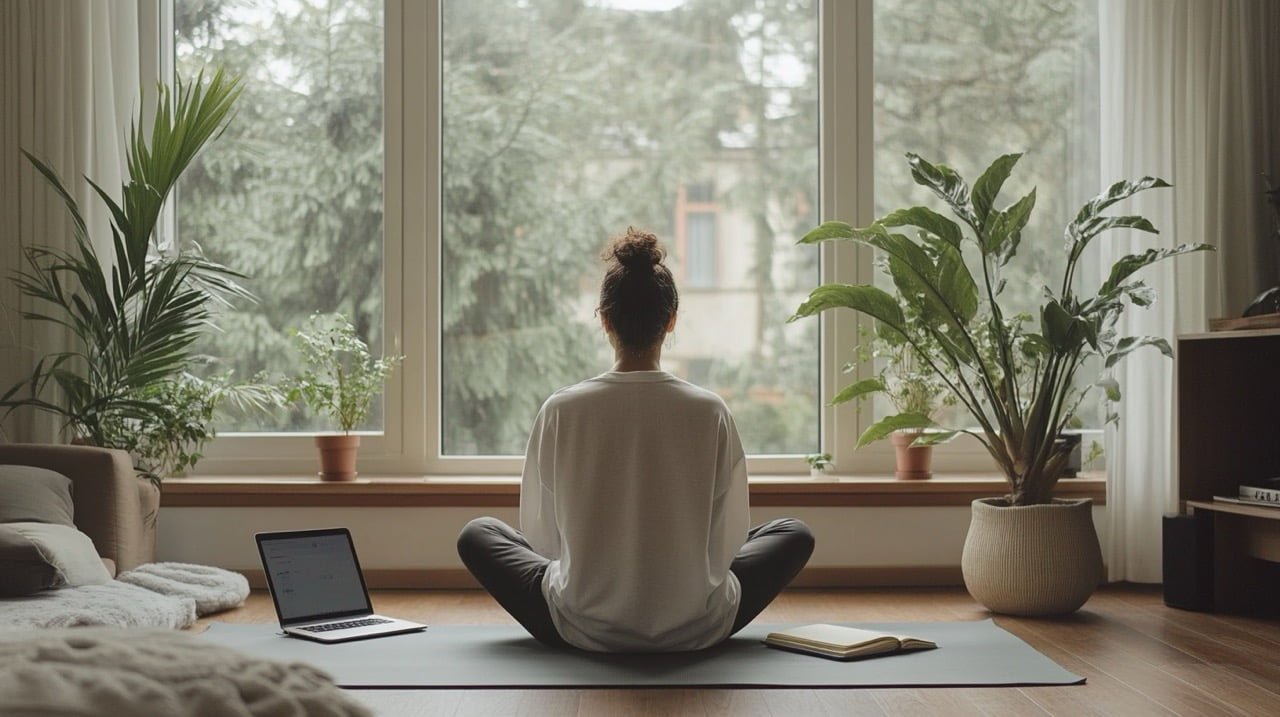Why do some people always seem to have a perfectly clean and tidy place despite their busy schedules? This post digs into the 10 tidy habits of folks who seem to effortlessly maintain spotless homes. You can adopt some or all of these habits to create a cleaner, more organised living space.
People with consistently tidy homes practice simple, yet effective daily routines and strategies. Their habits include prioritising tasks, mindful storage, regular cleaning, and efficient organisation, which together create a harmonious and clutter-free environment.
Table of Contents
#1 of 10 Tidy Habits: Start the Day with Purpose
Beginning your day with a purposeful task, such as making the bed or clearing kitchen counters, lays a strong foundation for a tidy and organised day. These seemingly small actions create a positive momentum that carries through the rest of your daily activities. Setting the stage for intentional orderliness from the moment you wake up helps you cultivate a more organised mindset.
Incorporating these little routines into your morning ritual not only keeps your home looking good, but can also even improve your mental well-being.
A tidy environment contributes to reduced stress levels, increased productivity, and a sense of pride in your living space. Plus, building and maintaining habits helps reinforce a sense of being in control and instill a sense of pride in your living space.
Set the Tone for the Day
By starting the day with intention and focus, you’re more likely to approach other tasks with a similar level of dedication and thoughtfulness.
As a result, you’ll find that your living space naturally becomes cleaner, more organised, and more enjoyable to inhabit.
Make it a priority to tackle at least one meaningful little task each morning and experience the benefits of a purpose-driven start to your day!
Setup a Laundry Schedule
Sticking to a consistent laundry schedule is crucial for keeping your home tidy and free from growing heaps of dirty clothes. By designating a specific day each week as “laundry day,” you create a reliable routine that ensures your laundry never spirals out of control.
Sticking to this schedule not only keeps your hamper from overflowing, but also makes the washing task more manageable and less overwhelming.
Having a laundry routine can also help you optimise your time and energy. By breaking the laundry process into smaller, more manageable tasks – such as pre-sorting clothes by colour and fabric type, pre-treating stains, and folding or hanging clothes immediately after drying and ironing – you can streamline the entire process.
Taking a systematic approach like this to household chores also reduces the likelihood of procrastination.
Master Your Hamper
To level up your laundry routine even more, consider organising your laundry space with dedicated bins or baskets for different clothing categories.
This will simplify the sorting process and save time when it comes to washing and drying. Additionally, keeping laundry supplies like detergent, fabric softener, and stain removers within easy reach of your washing machine obviously make the task go more smoothly.
Create a Paper Document Organisation System
Another thing super organised people always do is take care of incoming paperwork on the fly.
In today’s digital world, paper documents can still accumulate and create clutter in your home. Establishing a system for organising paper documents is essential if you want to prevent paperwork from stacking up.
By using folders, binders, or filing cabinets, you can create an efficient system that keeps your important papers in order and easily accessible.
To get started, get into the habit of sorting your inbound documents into categories such as:
- Recyclable: Junk mail, old newspapers, and other paper items that can be immediately discarded in the paper waste bin.
- Important/archive: Documents with long-term value, such as birth certificates, insurance policies, property deeds, and legal agreements.
- Action items: Papers that have a limited period of relevance, which you typically need to take action on rather quickly. Examples: bills, receipts, and invitations.
Use labeled folders or binders for archiving the important files you need to keep in hard copy. For action items, a physical inbox at your desk can be super helpful. Once you’ve completed anything from your inbox, discard it, scan it into your notes app if you need a digital copy, or archive it if you’re obligated to hold on to it.
Streamline Your Paperwork
To maintain your document organisation system, set aside a bit of time on a regular basis – weekly, monthly and quarterly, for example – to go through your papers and update your files as needed.
This may involve shredding or recycling outdated documents, archiving more important papers you’ve recently received, or cleaning out your physical inbox.
By implementing a paper document organisation system that works for you, you’ll not only create a more organised and clutter-free desk, but also reduce stress because you’ll never forget to pay a bill again. Plus, it will save you time when searching for important documents.
Keep the Refrigerator Clean
Let’s head to the kitchen for the next of our 10 tidy tips. Maintaining a clean and organised refrigerator is so helpful for meal preparation and grocery planning.
By dedicating a few minutes each weekend to clean out your fridge, you can prevent food from expiring, and condiment clutter and unwanted odours from accumulating. And regular maintenance not only contributes to a cleaner kitchen overall, but also makes it easier to access refrigerated items.
Maintain a Clean Fridge
Include these steps to thoroughly clean the refrigerator:
- Remove and discard expired food: Check the expiry dates of all items in your fridge and throw away anything that’s past its prime. Be sure to check containers of leftovers, condiments, and other perishables that may have been forgotten in the back.
- Wipe down shelves and drawers: Remove any crumbs, spills, and stains from the shelves and drawers by wiping them down with a damp cloth and a mild cleaning solution. This keeps things clean and scares off any bacteria.
- Reorganise your refrigerator contents: Arrange the items in your fridge by category, such as dairy, meats, fruits, and vegetables. This makes it easier to locate specific items and encourages a more efficient use of fridge space. Additionally, consider using labelled containers or fridge bins to store smaller items and keep your refrigerator organised.
- Check and adjust fridge temperature: To ensure your food stays fresh for as long as possible, check that your refrigerator is set to the correct temperature. The recommended temperature for most fridges is between 3-4°C (37-40°F).
- Monitor food inventory: Regularly assess the contents of your refrigerator to prevent overstocking and to reduce the likelihood of food waste. This habit will help you plan your meals and shopping more effectively, ultimately saving you time and money.
By incorporating weekly refrigerator maintenance into your routine, you’ll enjoy a cleaner, more efficient kitchen.
Designate Storage for Shoes and Coats
One key aspect of maintaining a tidy home is having a designated storage area for shoes and coats.
In the UK, parts of Asia and other places prone to rain, it’s especially important to have a well-organised space for wet outerwear and footwear. This prevents dirt and mud from being tracked into your living space.
Organise Outerwear Storage
Some ideas for creating an effective storage system for shoes and coats:
- Choose an appropriate location: Find a suitable spot in your home for shoe and coat storage, such as near the entrance or in the front hallway. This location should be easily accessible and provide enough space to accommodate the items.
- Use suitable storage solutions: Invest in appropriate storage solutions, such as coat hooks, shoe racks, umbrella stands or cubbies, to organise your items efficiently. Consider the size and style of your chosen storage options to ensure they fit seamlessly into your home’s decor and make the best use of available space.
- Get into the habit of using your landing space when you come home: Make a conscious effort to store your shoes and coats in their designated area right when you walk in the door. This habit really helps keep your entrance looking tidy.
- Maintain cleanliness: Keep the shoe and coat storage area clean by regularly sweeping or vacuuming to remove dirt and debris. This helps prevent dirt from being tracked into other parts of your home.
- Rotate seasonally: Adjust the storage of your shoes and coats according to the seasons. For example, during the summer months, store your winter coats and boots away in a closet, leaving space for lighter jackets and sandals. Rotating your items seasonally helps maximise storage space and ensures that you have easier access to season-appropriate clothing and footwear.
Wash Dishes Immediately
Among the 10 tidy habits of organised individuals, promptly washing dishes is high up there. Doing the dishes right after a meal really helps maintain a clean and clutter-free kitchen.
By washing your dishes immediately after use, you prevent the eyesore of dirty crockery piling up in the sink, and it just keeps your kitchen looking fresh and inviting.
This straightforward habit only takes a few minutes after mealtime, but can make such a significant difference in your home’s overall tidiness.
Stay on Top of Dishwashing
To make the most of this tidy habit, follow these tips:
- Rinse dishes as you go: As soon as you’re finished using a dish, give it a quick rinse to remove any leftover food particles. This makes it easier to wash later and reduces the risk of stubborn, dried-on stains.
- Dry dishes properly: If you don’t have a dishwasher or just prefer doing dishes by hand, dry them with a clean tea towel when you’re done washing up. This prevents water spots from forming.
- Put dishes away promptly: Once your dishes are clean and dry, put them away in their designated storage spaces. This is such an easy thing to do to keep your kitchen looking organised.
- Encourage good habits in others: If you share your living space with family members or housemates, encourage them to adopt the same tidy habit of washing dishes immediately. This will help maintain a consistently clean and organised kitchen for everyone to enjoy.
By incorporating the habit of washing dishes immediately into your daily routine, you can enjoy a cleaner, more welcoming kitchen space.
Keep Your Desk Uncluttered
Incorporating a clean workspace into your daily routine is one of the 10 tidy habits that can positively impact your productivity and overall well-being. A clutter-free desk encourages clear thinking, improves focus, and helps you stay organised throughout the day.
By dedicating a few minutes each day to maintaining a clean workspace, you’ll be better equipped to manage tasks efficiently and enjoy more peace of mind.
Cultivate a Tidy Workspace
To create and maintain a clean and organised workspace, follow these tips:

- Remove unnecessary clutter: Keep only the essential items on your desk to minimise distractions and create an open space for work. Store non-essential items in drawers or cabinets to keep your desk looking tidy and inviting.
- Organise your files and documents: Use folders, binders, or digital storage solutions like Devonthink to organise paperwork and prevent unsightly piles from accumulating on your desk. A well-organised filing system not only keeps your workspace tidy but also makes it easier to locate important documents when needed.
- Keep stationery and supplies in designated storage: Use desk organisers, drawers, or storage containers to store pens, paper clips, and other office supplies.
- Schedule regular cleaning sessions: Set aside a few minutes each day or at the end of the workweek to clean and tidy your workspace. Wipe down surfaces with a cloth, clean your computer screen and keyboard, and neatly stow away any random items.
- Personalise your workspace: You don’t have to get rid of the knick-knacks you like just because you want to be more organised. You can still keep personal touches like photos, artwork, or your favourite crystal at your desk to create a pleasant and inspiring environment. A workspace you feel happy in can boost your mood and help you stay motivated throughout the day!
- Encourage good habits in others: If you share a workspace with colleagues though, consider implementing a clean desk policy to promote a consistently tidy and organised environment that everyone can equally enjoy.
Regularly Dust Surfaces
Dusting surfaces consistently is another habit that can contribute to a cleaner and more inviting home. Routinely wiping away dust from flat surfaces can significantly reduce the need for time-consuming deep cleaning sessions.

Keep the Dust Bunnies at Bay
- Start from the top: When dusting, always begin with the highest surfaces in a room and work your way down. This ensures that any dust dislodged from higher areas won’t settle on surfaces you’ve already cleaned.
- Choose the right tools: Microfiber cloths are highly effective at capturing and trapping dust particles, making them an ideal choice for dusting. Additionally, consider using extendable dusters or vacuum attachments to reach high or difficult-to-access areas. Personally, I love my ostrich feather duster for daily dusting.
- Establish a routine: Incorporate dusting into your regular cleaning schedule to prevent dust buildup. Depending on the level of dust in your home, you may need to dust surfaces more frequently than not.
- Pay attention to overlooked areas: Don’t forget to dust often-neglected areas such as ceiling fans, light fixtures, air vents, and baseboards. These areas can accumulate dust just as easily as more visible surfaces.
- Practice preventative measures: To minimise dust buildup, consider using air purifiers, frequently changing air filters, and keeping windows and doors closed during high pollen or dusty days.
Hoover Regularly
Another one of the 10 tidy habits that organised people follow is regular vacuuming, ensuring that their floors remain clean and free from dirt and dust. I really think that keeping the floors clean and spotless is the ultimate way to give your place an overall clean look. It also prevents pollen and other allergens from accumulating in corners.
To make the most of your vacuuming routine, consider these tips:

- Choose the right hoover: Depending on your specific needs, select a vacuum cleaner with suitable features and attachments. For instance, if you have pets, opt for a vacuum designed to tackle pet hair effectively, such as a model from the Dyson Animal series.
- Develop a schedule: Establish a consistent hoovering routine based on the level of foot traffic and dust in your home. Stick to your schedule to maintain cleanliness and reduce the need for more intensive cleaning sessions.
- Pay attention to high-traffic areas: Focus on areas that receive the most foot traffic, such as hallways, living rooms, and staircases. These spaces typically collect more dirt and debris and may require more frequent vacuuming.
- Don’t forget about upholstery: Use your hoover’s attachments to clean sofas, chairs, curtains, and other soft furnishings. Regularly vacuuming these surfaces helps to remove dust, allergens, and debris that like to nestle into textiles.
- Maintain your hoover: Remember to empty vacuum bags or canisters regularly, as well as wash or replace filters as needed. This ensures optimal performance and a longer lifespan.
Stay Consistent with Vacuuming
By incorporating regular vacuuming as one of the 10 tidy habits, you’ll maintain a cleaner and more inviting living environment, while also prolonging the life of your carpets and rugs. This habit not only contributes to a visually appealing home, but also helps to promote a healthier and more comfortable space.
Do Daily Decluttering Bursts
Incorporating daily organising hacks into your routine is the final piece of the puzzle when it comes to the 10 tidy habits of organised individuals. By spending just 10 minutes a day focusing on decluttering a specific area, such as a closet, drawer, or shelf, you can keep your home tidy, prevent the buildup of unnecessary items, and foster a sense of accomplishment.
Master Daily Blitz Tidyups
These daily decluttering bursts are an effective way to manage your belongings and maintain order in your living space. Here are some tips to help you make the most of your daily tidying sessions:
- Prioritise areas: Start by identifying the areas in your home that require the most attention, and tackle them first. This might be a cluttered wardrobe, a messy kitchen cupboard, or a disorganised bookshelf.
- Set a timer: To ensure you stay focused and don’t get overwhelmed, set your phone’s timer for 10 minutes and concentrate on decluttering until the time’s up. This helps to create a sense of urgency and encourages you to make quick decisions about what to keep, discard, or donate.
- Sort items into categories: Whenever you declutter, sort items into three categories: keep, donate, and discard. This makes the process more efficient and helps you to assess what you genuinely need and what can be passed on to others or recycled.
- Organise and store: Once you have decluttered a specific area, take the time to organise the remaining items and store them in a neat and accessible manner. This might involve using storage boxes, labels, or dividers to create an orderly system that’s easy to maintain.
- Make it a habit: Consistency is key when it comes to daily decluttering. By incorporating this practice into your daily routine, you’ll gradually create a more organised and clutter-free environment, making it easier to maintain your home’s tidiness in the long run.
Embracing some of these 10 tidy habits, including daily decluttering bursts, will set you on the path to a well-organised and more harmonious living space. The more you practice these habits, the easier they become and the better you’ll be able to unwind when you’re home.
Before You Go…
Now that you’ve taken this deep dive into tidy home habits that can transform your home into a clutter-free sanctuary, why not explore some more tips and strategies to enhance your living environment? Here are some other articles to get you going:
- 10 of the Best Cleaning and Organising Podcasts are sure to keep you motivated when you’re tidying.
- 3 Things to Declutter Today if you’re in the mood to quickly get rid of some stuff.
- Why Under Bed Storage Is a Bad Idea, and where you can stow your stuff instead.




















Leave a Reply